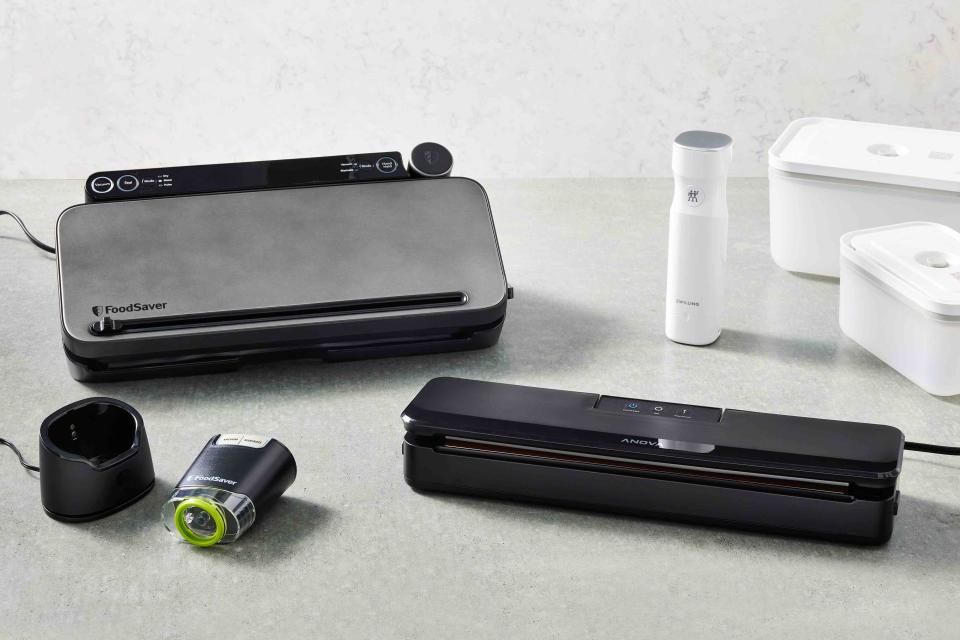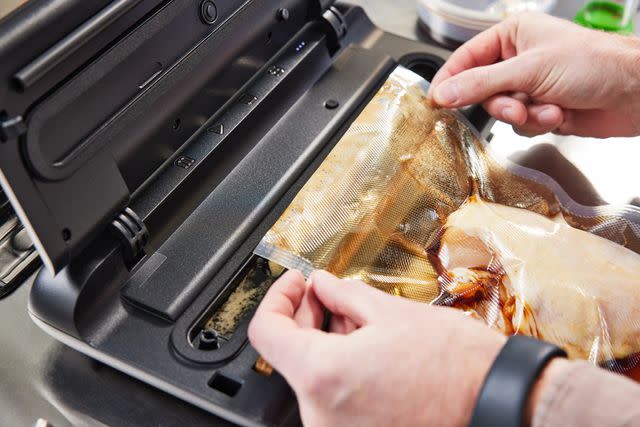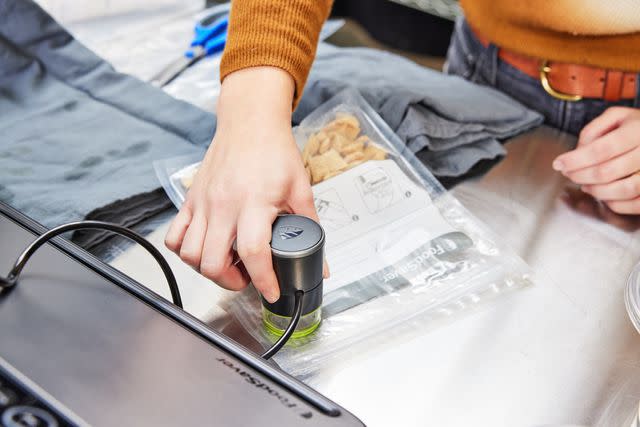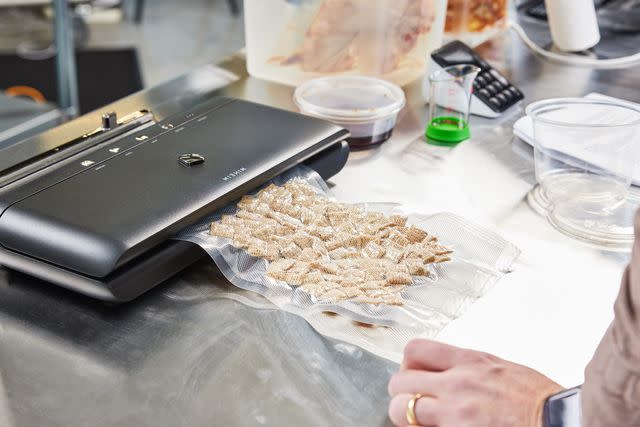Handheld vs. Countertop Vacuum Sealers
Dotdash Meredith and Yahoo Inc. may earn commission or revenue on some items through the links below.
We tested both to break down their differences (and pros and cons).

Serious Eats / Russell Kilgore
The vacuum sealer is a rather ingenious device that sucks the air out of a plastic bag before sealing it shut, preserving food and keeping moisture out. Do you tire of squeezing air out of zipper-lock bags for sous vide? Do you find that you're constantly throwing away freezer-burned food and stale snacks? A vacuum sealer may be right for you!
The vacuum sealers on the market today generally fall into two categories: handheld and countertop (we'll introduce a third, rarer option shortly). The former requires special bags with zip-top enclosures that work well for short-term storage, but could fail under certain conditions (like months in the freezer or long hours in a warm sous vide water bath). Countertop sealers are larger and seal the bag shut by melting the two sides together, a feature that makes the seal last longer. There is also *technically* a third style of vacuum sealer, the chamber sealer, that is most often used in commercial applications (though we did review one marketed towards home cooks—the Anova Precision Chamber Vacuum Sealer—and liked it). But which type of vacuum sealer is right for you? Here, we focused on countertop and handheld vacuum sealers, diving into their differences so you can choose which is best for your needs.
Countertop Vacuum Sealers
Nesco VS-12 Deluxe Vacuum Sealer

Anova Precision Vacuum Sealer Pro

Mueller Austria Vacuum Sealer Machine

Anova Precision Sous Vide Vacuum Sealer

Countertop vacuum sealers are sometimes referred to as channel sealers or edge sealers and feature a bar that heats up and melts the two sides of the plastic bag shut after removing the air. This type of sealer can be used with pre-cut bags or rolls that can be cut and sealed to a custom size. It's great for freezing, sous vide cooking, and even just keeping pantry items fresher for longer.
The Pros

Serious Eats / Russell Kilgore
Countertop models allow you to set and forget when it comes to sealing. Many models have the technology to detect precisely when the suction should end with regard to the type of food, eliminating the guesswork. In our testing, our favorites were reasonably priced, had simple controls, and reliably produced strong seals that held up to all kinds of tests. Some, like the Nesco Deluxe Food VS-12 sealer, were strong enough to remove all the air from irregular foods like a bone-in pork chop without breaking the plastic, but also delicate and “smart” enough not to crush Chex cereal. Many of the better models, like the Anova Pro, come with built-in storage for bags and a handy cutter. This model also lets you seal wet items, like chicken in a marinade, without sucking liquid up through the seal during the vacuum process.
Read More:We Tested 18 Sous Vide Machines (Immersion Circulators)—Here Are Our Favorites
The other nice thing about many countertop sealers is that you don’t need brand-specific bags, which are often more expensive. Instead, you can buy bags from third-party vendors for less than $1 a foot.
The Cons
The biggest cons with countertop vacuum sealers are that they are large and expensive. If you only vacuum seal sporadically, a big sealer might not be worth the cash and storage space. Aside from that, one minor quibble is that the bags for countertop vacuum sealers aren't really meant to be reused, while the bags that come with handheld sealer are designed (in theory) to be used repeatedly.
Handheld Vacuum Sealers
FoodSaver Handheld Vacuum Food Sealer Machine Cordless

Anova Precision Port Handheld Vacuum Sealer

Unlike their bulkier countertop cousins, handheld vacuum sealers are small, lightweight devices meant to fit in one hand. Some run on batteries (either disposable or rechargeable), and others employ a manual pump to remove air. Both kinds use special bags fitted with a one-way valve that attaches to the sealer. The bags are sealed with a zipper at the top that allows for easy opening and closing.
The Pros

Serious Eats / Russell Kilgore
The bags for a handheld vacuum sealer can be reused as long as the plastic isn’t punctured, and some have attachments to fit onto food storage containers and mason jars, which is something most countertop sealers can’t do. Handheld sealers also tend to be much smaller, lighter, and cheaper. These attributes make this type of sealer a good choice for those with less storage space or who might only vacuum seal sporadically.
The Cons
Handheld sealers require you to monitor the suction process, and you have to decide when to stop the device (unlike countertop sealers, which allow you to press a button and walk away). They use disposable or rechargeable batteries, and some can be operated manually (pump it!), but these tend to stink (sorry). In our test of vacuum sealers, we evaluated four handheld options, and two were surprisingly okay: the FoodSaver Handheld Cordless Vacuum Sealer and the Anova Precision Port Handheld Vacuum Sealer. Both were pretty easy to use, did a decent job suctioning and sealing, and were small and easy to stash away. The other two tested had some issues, with seals that failed to stay tight during various tests (if you want to seal anything in a marinade with them, good luck!). Overall, their power and seal quality just weren't as good as a countertop sealer. Also, handheld sealers require you to buy the bags from the manufacturer, as only those will have a valve compatible with the sealer. Plus, countertop sealers often have built-in bag cutting, which is a nice perk.
Handheld vs. Countertop Vacuum Sealers: Which Should I Buy?
Both handheld and countertop vacuum sealers have the same goal (vacuum suctioning and sealing), but choosing which is best for your needs comes down to how often you intend to use it, among other things. Let’s take a look at some of the key differences:
Factors | Handheld | Countertop |
Range of Features | Limited, mostly just suction | Suction, sealing, bag cutting |
Cordless? | Yes | No |
Price Range | $20-$70 | $40-$200+ |
Size | Compact, could fit in a drawer | Ranges widely, though compact models do exist |
Brand-specific bags? | Yes | No |
A small drawback of countertop sealers is that, as you open and close the bag, you have to cut the edges where it was sealed, and if you want to re-seal it, well, your bag just got smaller. While this isn't a dealbreaker for us (you could just use a new bag), countertop sealers do tend to be more expensive and rather large compared to more petite handheld offerings.
On the flip side, countertop sealers can produce an extremely durable seal that won’t fail. In our testing, we placed sealed bags into a water bath (at 200°F) for 36 hours, and the best ones didn’t budge or leak. This comes in handy if you plan to subject one package of food to a range of environments, such as marinating a cut of beef before freezing it, then using sous vide to cook it later. If your seal fails during cooking, all that work will end up as wasted (and waterlogged) food.
The Takeaway

Serious Eats / Russell Kilgore
In general, we recommend countertop vacuum sealers (our favorites were from Nesco and Anova) because they offer a much wider range of functions and often seal better than their handheld counterparts. Plus, the higher cost of the bags for handheld sealers can add up quickly.
FAQs
What is a vacuum sealer good for?
A vacuum sealer is good for extending the shelf-life of food, which can reduce waste. Beyond edible items, vacuum sealers can also help preserve important items and keep them safe from moisture and air.
Do I need a vacuum sealer?
Almost anyone can use a vacuum sealer for one project or another, but if you want to make the most of bulk shopping or are interested in trying sous vide cooking, you definitely need one. Even if you just need to freeze meat or vegetables occasionally, a vacuum sealer is great at preventing freezer burn.
Are countertop vacuum sealers worth it?
Countertop vacuum sealers are better for batch sealing projects and can be operated hands-free. This type of sealer generally has a more powerful motor and comes with a sealing bar, which is less prone to leakage than a zip-top bag. The value of a countertop vacuum sealer will vary from person to person, depending on lifestyle.
Are handheld vacuum sealers worth it?
Handheld vacuum sealers may be worth it for those that are interested in meal prep or small-scale preservation, but won’t use it often enough to justify the cost (and countertop space) of a countertop model.
Can you vacuum seal without a machine?
You can remove most of the air from a Ziploc bag with a simple technique, which can serve in a pinch. Remember that this method is “nearly air-free,” and you may find some differences between these results and using a proper vacuum sealer.
Read More:We Tested 19 Vacuum Sealers—Here Are the Best Ones

